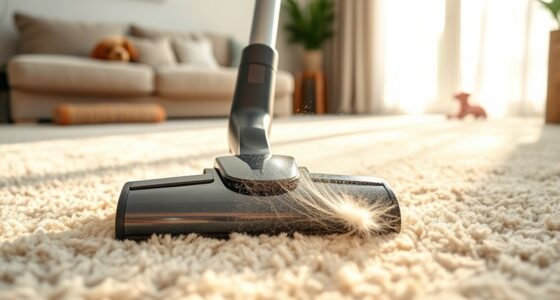To create a healthy home workspace, focus on your environment. Use ergonomic furniture to support good posture and reduce strain. Position your desk near windows for natural light, which boosts mood and alertness. Keep your space organized to promote clarity and efficiency. Add personal touches like plants to improve air quality and create a calming atmosphere. Prioritizing comfort and organization leads to better productivity. You’ll discover more tips to enhance your workspace effectively.
Key Takeaways
- Choose ergonomic furniture to support proper posture and reduce the risk of chronic pain while working.
- Utilize natural lighting by positioning your desk near windows to enhance mood and regulate your circadian rhythm.
- Keep your workspace organized and clutter-free to promote mental clarity and improve efficiency during tasks.
- Incorporate plants into your workspace to improve air quality and create a calming atmosphere.
- Optimize lighting and prioritize comfort to reduce eye strain and enhance overall well-being while working.

Have you ever considered how your workspace affects your well-being? The environment where you spend countless hours working can markedly impact your productivity and health. If you haven’t thought about it yet, now’s the time to reassess your setup. A healthy home workspace is more than just a desk and a chair; it’s about creating an atmosphere that promotes comfort and efficiency.
First off, let’s talk about furniture. Investing in ergonomic furniture can make a world of difference. An ergonomic chair, for instance, supports your back, encourages good posture, and reduces the risk of developing chronic pain. You might think that comfort is a luxury, but when you’re working long hours, it becomes a necessity. Adjusting your chair height, ensuring your knees are at a right angle, and having proper lumbar support can enhance your focus and keep distractions at bay. Your desk should also be at the right height to prevent strain on your arms and wrists. By prioritizing ergonomic furniture, you’re taking a vital step toward maintaining your physical health while working from home.
Next, let’s consider the importance of natural lighting. Have you ever noticed how your mood shifts when you’re in a bright, sunlit room? Natural light not only boosts your spirits but also helps regulate your circadian rhythm, which can improve your sleep quality and overall health. If possible, position your desk near a window to maximize the amount of sunlight you receive. If that’s not an option, think about incorporating bright light bulbs to mimic natural light. A well-lit workspace can reduce eye strain and keep you alert, making it easier to tackle your tasks efficiently.
Don’t forget about the overall organization of your space. A clutter-free environment can lead to a clearer mind. Take time to declutter and organize your workspace so you can find what you need without hassle. Adding personal touches like plants can improve air quality and create a calming atmosphere, which is essential for those long workdays.
Frequently Asked Questions
What Plants Are Best for Improving Air Quality in a Workspace?
For improving air quality in your workspace, consider adding air purifying plants like snake plants, peace lilies, and spider plants. These plants not only filter toxins but also add stress reducing greenery that enhances your mood. You’ll find that incorporating them into your environment can lead to a more invigorating atmosphere. Plus, they’re relatively easy to care for, so you won’t have to worry about extensive maintenance while enjoying their benefits.
How Can I Reduce Noise Distractions While Working From Home?
To reduce noise distractions while working from home, you can use soundproofing techniques like adding heavy curtains, rugs, or acoustic panels. These materials absorb sound and minimize echoes. Consider investing in noise canceling devices, such as headphones or white noise machines, to block out unwanted sounds. Creating a designated workspace away from noisy areas can also help you focus better. With these strategies, you’ll find it easier to concentrate on your tasks.
What Are the Benefits of Using an Ergonomic Chair?
Using an ergonomic chair can feel like having your own throne, offering key benefits for your work life. You’ll experience excellent posture support that helps maintain proper spinal alignment, reducing strain and discomfort. With improved comfort, you’ll find it easier to focus and work longer hours without fatigue. Plus, investing in an ergonomic chair can prevent long-term health issues, allowing you to reign over your productivity with ease and grace.
How Often Should I Take Breaks During Work Hours?
You should take breaks every 60 to 90 minutes during work hours. Use these stretch breaks to stand up, move around, and relieve tension. It’s also a great time for hydration reminders—grab a glass of water to stay refreshed. Incorporating these breaks into your routine not only boosts your productivity but also helps maintain your overall well-being. So, set a timer and make those breaks a priority!
What Lighting Is Ideal for a Home Office Setup?
For your home office setup, the ideal lighting combines task lighting and natural sunlight. Position your desk near a window to take advantage of daylight, which boosts mood and productivity. Use adjustable task lighting for focused work, ensuring it’s bright enough without causing glare on screens. Consider a warm light tone to create a cozy atmosphere. Balancing these light sources helps reduce eye strain and keeps your workspace inviting.
Conclusion
In crafting your healthy home workspace, remember it’s not just about the desk and chair; it’s about creating an environment that nurtures your well-being. Like a garden needs sunlight and water to flourish, your workspace thrives on good air, organization, and personal touches. So, take a moment to assess your surroundings, make adjustments, and watch your productivity bloom. With a little effort, you’ll cultivate a space where creativity and focus can truly take root.










